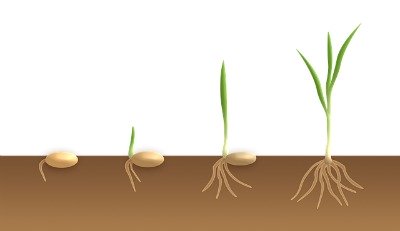In broad terms, the stages of development in plants can be divided into the following: vegetative, reproductive, ripening, and senescence.
Each stage can be subdivided into various component substages or phases.
Although plant development is cyclical, here the seed is considered as the starting point for the sequential events leading to a mature plant, the formation of seed, and finally death.
The stages of development are listed hereunder in order of occurrence and should also provide at least a general picture of how plants grow from seeds until they die.
The Major Stages of Development in Plants
1. Vegetative Stage
This is generally a lengthy period of development in plants, starting from seed germination until prior to the reproductive stage.
In seed germination, the young, quiescent plant (embryo) within the seed initiates active growth and ultimately the embryonic root (radicle) and the embryonic shoot (epicotyl) extend outward from the seed. (click here to read Parts of a Seed)

The seedling emerges from the soil and soon assumes independent growth.
Subsequently, the plant grows bigger with more roots and more aerial parts such as tillers (as in rice), nodes and internodes, branches, and leaves.
This stage terminates immediately before it reaches the reproductive stage at which time it starts to initiate the formation of inflorescences (i.e., panicle in rice) and flower primordia.
In trees and other perennial crops, this stage of development is also called the juvenile stage during which the tree progressively increases in root mass and size of the trunk, branches, canopy, and height, but not reproductive parts.
Thus a tree that cannot be induced to flower is referred to as a juvenile while another which has reached fruit-bearing age is called mature or adult.
In seed-grown mango (Mangifera indica L.), juvenility may last for about 5 years or more and coconut for about 3 years or more, depending on the variety, care, and environmental conditions.
Stated another way, it takes mango about 5 years or more and coconut about 3 years or more to start producing flowers, fruits, and seeds.
2. Reproductive Stage
This stage of development in plants occurs after the vegetative or juvenile stage is completed.
At this stage the plants are considered mature, that is, they are physiologically capable of commencing the production of reproductive parts: the flowers, fruits, and seeds.
This stage consists of the period from the time that the plant starts to form inflorescence or flower primordia (called booting in rice) until flowering, pollination, and fertilization.
According to Ryugo (1988), in fruit trees, the reproductive stage commences with a transition phase during which few flowers are produced.
3. Ripening stage
In annual crops, this is the developmental stage during which botanical fruits (click here to read more on What is a Fruit?) and seeds are formed.
But for horticultural crops, ripening has been defined as “the composite of the processes that occur from the latter stages of growth and development through the early stages of senescence and that results in characteristic aesthetic and/or food quality, as evidenced by changes in composition, color, texture, or other sensory attributes” (Watada et al. 1984).
In rice, ripening starts after fertilization (syngamy) and ends when the grains (commonly called seeds) become mature (GRiSP 2013).
A seed is physiologically mature when it has achieved maximum accumulation of dry matter (and dry weight).
However, at this stage of maturity, the seeds would have a high moisture content of about 30-35%.
To accelerate the drying of seeds even while still attached to the plant, it is a common practice to drain the paddy field of water about 1-2 weeks before the harvest schedule.
4. Senescence
This is the final stage of development in plants during which physical and chemical changes occur leading to the death of the whole plant.
In annual plants, senescence may start during the reproductive stage and plant death sets in soon after seed maturity which marks the end of irreversible growth.
Progressive change in color from green to yellowish (chlorosis) is a major indicator of leaf senescence and the start of whole-plant death.
REFERENCES
- COPELAND LO. 1976. Principles of Seed Science and Technology. Minneapolis, MN: Burgess Pub. Co. 369 p.
- FEININGER A. 1968. Trees. NY: The Viking Press. p. 81.
- GRiSP [Global Rice Science Partnership]. 2013. Rice almanac, 4th edition. Los Baños, Philippines: International Rice Research Institute. 283 p.
- ISHIZUKA Y. 1973. Physiology of the rice plant. Food & Fertilizer Technology Center. Tech. Bull. No. 13. p. 241-315.
- KESSELER R, STUPPY W. 2009. Seeds: Time Capsules of Life. Buffalo, New York: Firefly Books (US) Inc. 264 p.
- RYUGO R. 1988. Fruit Culture: Its Science and Art. New York: John Wiley & Sons. 344 p.
- SCHULMAN E. 1958. Bristlecone pine, oldest living thing. The National Geographic Magazine. CXIII(3):355-372.
- WATADA AE, HERNER RC, KADER AA, ROMAN RJ, STABY GL. 1984. Terminology for the description of developmental stages of horticultural crops. HortScience. 19(1):20-21. Retrieved Mar. 14, 2015 from http://ucanr.edu/datastoreFiles/234-426.PDF.
- [USDA] United States Department of Agriculture. 2011. McKinley grove giant sequoia’s high sierra ranger district. Retrieved May 7, 2015 from http://www.fs.usda.gov/Internet/FSE_DOCUMENTS/stelprdb5344073.pdf.
